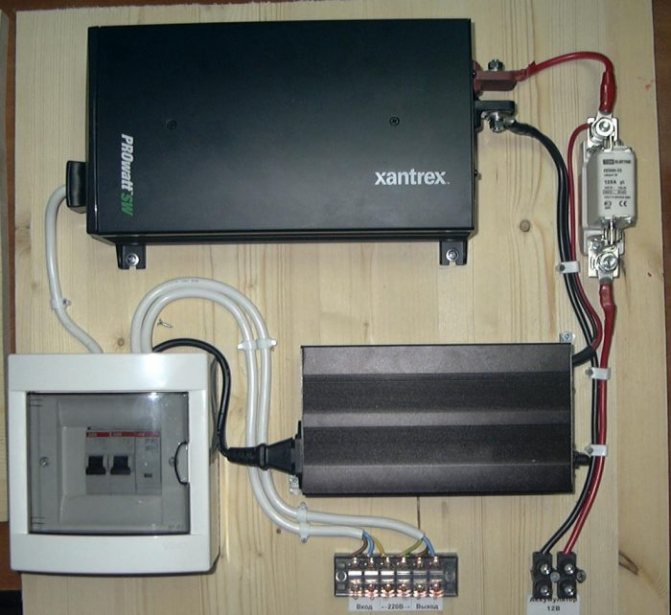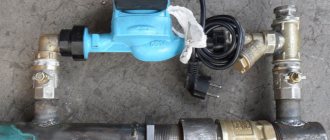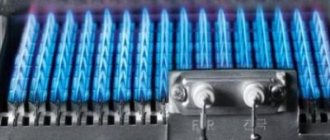Autonomous heating systems are directly related to the operation of an electric pressure pump. These systems are very efficient, trouble-free and safe. But everything can change in an instant - if the centralized power supply is turned off. The probability that a major accident may occur in the heating circuit is very high. To prevent this from happening, you need an uninterruptible power supply for the heating circulation pump.
Benefits of uninterruptible power supplies for circulating pumps

It is not hard to imagine which unpleasant consequences will freeze the water in the system in winter. Only one replacement of burst pipes and radiators will cost the owners a pretty penny.
Parametric failures in the electrical network are capable of disabling the boiler electronics. it voltage drop up to 160-170 V (in single-phase units) during peak periods of power consumption, amplitude jumps and alternating current deviations frequency of 50 Hz.
Design UPS or UPS (Uninterruptible Power Supply) is a device with a rechargeable battery and a DC-AC converter (direct current → alternating current). The inverting process of the UPS is controlled by a microcontroller with a crystal oscillator.
The UPS is distinguished from other alternative sources by:
- compactness of devices, which allows the production of products in a tabletop / floor version;
- ease of connection and operation, quiet operation the entire model line of uninterruptible power supplies;
- relative cheapness most headings;
- basic protection of the electric motor and electronics of the autonomous hot water supply system;
- no maintenance costs during use;
- long service life (with battery recharging): 3-5 years or more;
- minimum time pause or lack thereof when switching "backup power ↔ network";
- almost sinusoidal output voltage with minimal distortion;
- the ability to change the frequency and voltage on the connected load.
Advantages and disadvantages of different types of UPS
Each device has pros and cons:
- Standby UPS. Differs in increased efficiency, practically does not make noise and does not heat up, it is inexpensive, but at the same time it takes a lot of time when switching and distorts the shape of the voltage at the output. In such devices, it is not possible to correct the amplitude and frequency of the current.
- Line-interactive source. Does not make noise and maintains high efficiency, stabilizes the voltage by means of an autotransformer. The disadvantages include low accuracy, long switching period and trapezoidal voltage. Also, inexpensive models can exhibit frequency deviations.
- Inverter units. Advantages - accuracy of stabilization, operation in a wide range of mains voltage, instant switching and no interference at the output with an ideal form of voltage supply. But such a device is expensive and constantly makes a fan noise.


For the heating pump to work properly, the UPS must provide a sinusoidal signal, and if the output is converted to a square, stepped sinusoid or trapezoid, the pump motor will be overloaded, leading to rapid equipment failure. The required signal parameter is given only by the inverter unit, so if the power supply is often cut off in the house, it is worth purchasing just such a UPS. Redundant sources are suitable for buildings with rare interruptions to the central power supply.
UPS types
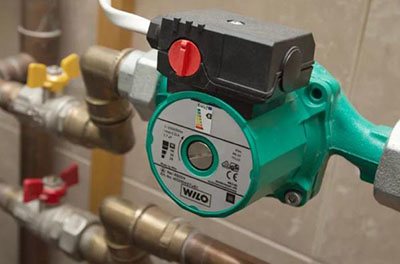

The uninterruptible power supply, depending on the options supported, provides the following functions:
- automatic switching to be powered by a storage battery (AKB) in emergency situations;
- inversion of constant DC voltage (12V) into the required alternating voltage (220 V) with frequency correction of 50Hz;
- smoothing out power surges and filtering network noise with a duration 10-100 ms;
- stabilization of the "transit" mains voltage in the normal mode.
Reference! All UPSs / UPSs are responsible for transferring the heating pump power to the battery, converting the voltage and filtering line noise. Voltage stabilization is performed only by devices equipped with a stabilizer block.
Exist three kinds uninterruptible power supplies, which are also used to work with circulation pumps of heating systems.
Reserve
The simplest budget models provide only the transition to spare power. Normally the mains voltage goes directly to the boiler without stabilizationby passing one passive surge suppression filter.


Photo 1. A reserve budget UPS can only provide a transition to a spare power supply.
In the event of a mains power failure, parameters exceeding the range values, the switch connects the standard battery in 4–12 ms. The constant voltage of the battery is first fed to the electrical converter, where it becomes variable, and then rises to the required 220 V.
Line-interactive sources
These UPSs are more advanced than standby ones. They feature a built-in voltage regulator that corrects for voltage failures. in the range of 25% of the nominal value. This makes it possible to work at fairly large voltage surges without connecting the battery to the process.
Technically, this problem is solved by installing an autotransformer that monitors the deviation of the alternating voltage from a given value. In devices no sinusoidal correction provided mains voltage.


Photo 2. Line-interactive uninterruptible power supply with built-in stabilizer corrects voltage failures.
Inverter uninterruptible devices
In the multicomponent circuit of these devices, the principle of double inversion is implemented. Serviced boiler equipment, regardless of the state of the network, always powered by a battery.
In the absence of mains voltage, the usual DC → AC conversion similar to standby UPS. Direct current is supplied to the battery terminals for recharging.
Inverter UPSs reproduce stable electrical parameters, this type of device is optimal for supplying heat pumps.
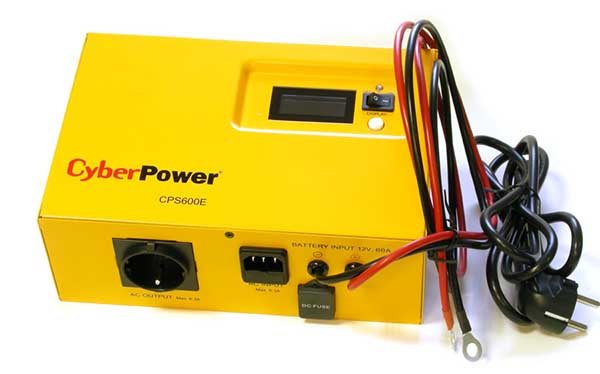

Photo 3. Cyber Power inverter uninterruptible power supply is used to supply heating circulating pumps.
UPS models
PN-1000 energy is a powerful backup power source. Thanks to the built-in stabilizer, the device provides a nominal output voltage when the mains voltage changes within 120-275 volts. The waveform in the form of a smooth sine wave is ideal for supplying reactive inductive loads, such as the electric motor of a heating system pump. The PN-1000 energy together with the Delta DTM 12100L 100A / h accumulator provides uninterrupted power supply for the 150W heating pump for 8 hours. The device has a built-in line noise filter, information display and RS-232 interface.
You can find this and other voltage stabilizers for the heating system from the Energia company on the website of the official representative of the Energiya.ru company.
The compact emergency power supply Teplokom 222/500 is intended for use in heating gas systems. This simple device with a single-phase relay-type regulator allows operation with a load not exceeding 230 W.
The universal stabilizer Skat ST 1515 provides a voltage of 220 V with network fluctuations from 145 to 260 V and a frequency of 50 Hz ± 1%. If the voltage exceeds the specified parameters, the load will be disconnected automatically.
Summing up
Based on the operational requirements for electric motors of heating pumps, the UPS must provide the following parameters:
- The voltage form is a smooth sinusoid;
- Power reserve - not less than 20%;
- Automatic load disconnection;
- Minimum switching time to reserve.
In addition, the device must operate in a certain temperature range, have a device for indicating modes and physical quantities.
Read with this:
How to choose a three-phase voltage regulator?
Choosing an electromechanical voltage regulator: features, advantages and disadvantages
Choosing a battery for a UPS: characteristics, features and types of batteries
Choosing a relay voltage stabilizer: design, advantages and disadvantages
Did you like the article? Share with your friends on social networks!
What kind of UPS is needed for the boiler?
The main purpose of the UPS / UPS is to ensure the supply of electricity through the charge of the built-in rechargeable battery. Desktop UPS models are common, but they are more suitable for computers.
Taking into account the provision of the starting current, one battery charge is enough for 30-40 minutes of continuous work home DHW network.
To extend the autonomy time up to several hours, it is better to choose such a UPS model, which provides the ability to connect additional external batteries.
Attention! Equipment should be chosen with LT (Long Time) marking... This means that external storage capacities are connected and monitored. Helium accumulators are irreplaceable as additional batteries.
At the same time, uninterruptible power supplies improve the quality of the main power supply, preventing the parameters from going beyond the permissible limits.


In our case, voltage stabilization is acceptable in the range of 220 V ± 5% with frequency maintenance of 50 ± 0.2 Hz.
The difference between a UPS and a backup power source (generator, mini-power plant) is that the device switches to battery mode in 3-10 milliseconds.
In the case of use of uninterruptible power supplies with double conversion of frequency, there is no switching delay at all.
The use of the device with such a minimum duration / absence of a "pause" will not lead to a malfunction of the automation or stop the pump of the DHW system.
Important! The boiler circulation pump is sensitive to the shape of the supplied voltage. It is required to select a device that inverts 12 in constant voltage battery to variable 220V 50Hz with a "pure" sinusoid.
The last requirement is indicated by manufacturers in the equipment product cards. It means that the distortion of the sinusoidal current at the output of the UPS / UPS does not exceed 8%... Compliance with this condition will ensure silent operation of the pump and significantly will extend the life of the electric motor.
Catalog of Uninterruptible Power Supplies for Pumps
Compare products Selected products: 0
show all Total in this category: 19
Products per page: from 1
by
19
| Sort by: | popularity | power | the price | ||
| Model | Dimensions (edit) | Brand name | Power | Price | |
| UPS IMPULSE STAYER 11-1 Power: 0.9 kW | 1 kVA Voltage (in / out): 220V / 220V A type: double conversion Warranty: 2 years | 144х400х215 mm | PULSE | 0.9kw | Send request | |
| UPS IMPULSE SPRINTER 11-10 Power: 9 kW | 10 kVA Voltage (in / out): 220V / 220V A type: double conversion Warranty: 2 years | 250 x 590 x 655 mm | PULSE | 9 kWt | Send request | |
| UPS Makelsan PowerPack SE 1 kVA Check availability Power: 0.9 kW | 1 kVA Voltage (in / out): 220V / 220V A type: double conversion Warranty: 2 years | 144 x 336 x 214 (S); 144 x 414 x 214 (S); 144 × 336 × 214 (H) mm | Makelsan | 0.9kw | 23 166 rbl | |
| UPS IMPULSE SPRINTER 11-6 !Super price! Special reduced price + high quality (2 years warranty!) From the official manufacturer Power: 5.4 kW | 6 kVA Voltage (in / out): 220V / 220V A type: double conversion Warranty: 2 years | 250 x 590 x 655 mm | PULSE | 5.4kw | Send request | |
| UPS Makelsan PowerPack SE 2 kVA Check availability Power: 1.8 kW | 2 kVA Voltage (in / out): 220V / 220V A type: double conversion Guarantee: 2 years | 191 x 418 x 335 mm | Makelsan | 1.8kw | 40,291 rbl | |
| UPS IMPULSE SPRINTER 11-3 !Super price! Special reduced price + high quality (2 years warranty!) From the official manufacturer Power: 2.7 kW | 3 kVA Voltage (in / out): 220V / 220V A type: double conversion Guarantee: 2 years | 191x470x336 mm | PULSE | 2.7KW | Send request | |
| UPS IMPULSE SPRINTER 11-2 Power: 1.8 kW | 2 kVA Voltage (in / out): 220V / 220V A type: double conversion Guarantee: 2 years | 191x470x336 mm | PULSE | 1.8kw | Send request | |
| UPS Makelsan PowerPack SE 3 kVA Check availability Power: 2.7 kW | 3 kVA Voltage (in / out): 220V / 220V A type: double conversion Guarantee: 2 years | 191 x 418 x 335 (S); 191 x 464 x 335 (S); 191 x 418 x 335 (H); mm | Makelsan | 2.7KW | 44 981 rub | |
| UPS IMPULSE SPRINTER 11-1 !Super price! Special reduced price + high quality (2 years warranty!) From the official manufacturer Power: 0.9 kW | 1 kVA Voltage (in / out): 220V / 220V A type: double conversion Guarantee: 2 years | 144х400х215 mm | PULSE | 0.9kw | Send request | |
| UPS Makelsan PowerPack SE 6kVA 1/1 Check availability Power: 5.4 kW | 6 kVA Voltage (in / out): 220V / 220V A type: double conversion Guarantee: 2 years | 262 x 514 x 735 mm | Makelsan | 5.4kw | 106 732 rub | |
| UPS IMPULSE STAYER 11-3 !Super price! Special reduced price + high quality (2 years warranty!) From the official manufacturer Power: 2.7 kW | 3 kVA Voltage (in / out): 220V / 220V A type: double conversion Guarantee: 2 years | 191x470x336 mm | PULSE | 2.7KW | Send request | |
| UPS IMPULSE STAYER 11-2 Power: 1.8 kW | 2 kVA Voltage (in / out): 220V / 220V A type: double conversion Guarantee: 2 years | 191x470x336 mm | PULSE | 1.8kw | Send request | |
| UPS Makelsan PowerPack SE 10kVA 1/1 Check availability Power: 9 kW | 10 kVA Voltage (in / out): 220V / 220V A type: double conversion Guarantee: 2 years | 262 x 514 x 735 mm | Makelsan | 9 kWt | 131 887 rub | |
| UPS IMPULSE SPRINTER 33-15 !Super price! Special reduced price + high quality (2 years warranty!) From the official manufacturer Power: 13.5 kW | 15 kVA Voltage (in / out): 380V / 380V A type: double conversion Guarantee: 2 years | 250 × 828x868 mm | PULSE | 13.5kw | Send request | |
| UPS Makelsan PowerPack SE 10kVA 3/1 Check availability Power: 9 kW | 10 kVA Voltage (in / out): 380V / 220V A type: double conversion Guarantee: 2 years | 262 x 580 x 732 (S); 262 × 580 × 455 (H) mm | Makelsan | 9 kWt | 177 082 rub | |
| UPS IMPULSE STAYER 11-6 !Super price! Special reduced price + high quality (2 years warranty!) From the official manufacturer Power: 5.4 kW | 6 kVA Voltage (in / out): 220V / 220V A type: double conversion Guarantee: 2 years | 250 × 655 × 590 mm | PULSE | 5.4kw | Send request | |
| UPS IMPULSE STAYER 11-10 Power: 9 kW | 10 kVA Voltage (in / out): 220V / 220V A type: double conversion Guarantee: 2 years | 250 × 655 × 590 mm | PULSE | 9 kWt | Send request | |
| UPS Makelsan PowerPack SE 15kVA 3/1 Check availability Power: 13.5 kW | 15 kVA Voltage (in / out): 380V / 220V A type: double conversion Guarantee: 2 years | 262 x 580 x 628 mm | Makelsan | 13.5kw | 217 586 rub | |
| UPS Makelsan PowerPack SE 20kVA 3/1 Check availability Power: 18 kW | 20 kVA Voltage (in / out): 380V / 220V A type: double conversion Guarantee: 2 years | 262 x 580 x 628 mm | Makelsan | 18 kWt | 241 320 rub | |
How to make a UPS for a heating system with your own hands
Assemble yourself an uninterruptible power supply capable of within a few days to keep the boiler running, the following manual will help.
Required set of components


For independent design of the UPS, such ready-made modules and components are purchased:
- 2 car batteries for 12 V with a capacity of 225 A ∙ h;
- pulse power supply unit (PSU) 28.8 V at 50 A;
- a 28.8 V inverter-converter with a 310 V meander output;
- power resonant filter of higher harmonics 310/220 V
- power cord with plug, pieces of insulated wire, connectors and connectors, housing.
Phased assembly
All components are placed in the case, components are connected in the following order:
- We connect "+" and "-" pairs of batteries with a jumper to a serial battery, free terminals are connected to the output of the switching power supply.
- To these terminals connect the inverter, and we equip the power supply input with a wire with a plug for connection to the network.
- The inverter output is connected to the filter, at the output of which we obtain the voltage 220 V 50 Hz with "pure" sine.
Rules for choosing a UPS for a pump
When selecting equipment, you need to look at the following indicators:
- power;
- battery capacity;
- period of autonomous work;
- the possibility of using external batteries;
- mains voltage range;
- accuracy and the presence of voltage distortion at the output;
- time of transition of work to a spare battery.
The defining indicator is the power of the device, which should be calculated in advance.
How to calculate the power rating of a UPS
When carrying out calculations, not only the operation of the pump, but also the heating boiler is taken into account. In the passport for the circulation pump for the heating system, the power can be indicated in watts (thermal power), in order to find out the total power, you need to divide the thermal power parameter by Cos ɸ, this parameter can also be indicated in the product data sheet.
For example, pump power (P) is 90W and Cos ɸ is 0.6. The formula P / Cos ла is applied, the result is (90 / 0.6) 150 W. Now you need to multiply the reactive power (150 W) by three, since when the engine starts, the current consumption increases three times. The formula is P / Cos ɸ * 3. For the example shown, the required power supply is 450 watts. If Cos ɸ is not indicated in the documents, the heat output of the pump is divided by a factor of 0.7.
Installation of a circulation pump in the heating system and wiring diagram
How to determine the capacity of batteries
The parameter is needed to find out the period of operation without mains current. As a rule, UPSs for the heating pump are not equipped with batteries with sufficient battery capacity, therefore, to maintain the operation of the pump in conditions of frequent power outages, it is necessary to choose uninterruptible power supplies with the ability to connect external batteries.
How to choose the input voltage


The standard parameters of the mains voltage are 220 volts with permissible deviations of +/- 10%, which is approximately 198-242 volts. This means that all devices must operate within the specified limits, but in small settlements significant deviations from the established parameters are possible. If there are power surges in the network, then it is better to pre-measure the voltage indicators of the network during the day. Measurements are taken several times, the readings are recorded. Such data will allow you to select a UPS, where the data sheet indicates the maximum voltage parameters at which the device can supply an output voltage as close as possible to the nominal.
How to choose the shape and indicators of the output voltage
If the output voltage of the uninterruptible power supply is within the 10% tolerance, then the device is suitable for connecting a circulation pump for the heating system. As a rule, the time for switching to the backup power source does not take more than ten microseconds, so the pump motor does not have time to stop. But the shape of the output signal is an important parameter of the uninterruptible power supply device, which ensures the correct operation of the pump.
To guarantee the normal operation of the system, it is necessary to obtain a voltage in the form of a smooth sinusoid, which is produced only by a double conversion device. In addition, the inverter accumulator for the heating pump provides accurate voltage and frequency.
Important! The UPS is operated in rooms with the temperature indicated in the product passport, the air should not contain vapors of harsh and corrosive reagents, and the ground loop is made in accordance with the regulatory rules for the use of electrical installations.
General recommendations for choosing the right UPS


It must be borne in mind that a gas boiler with one circulation pump and an electronic control unit requires up to 300 W power consumption. The UPS must be selected so that the rated power was not less than this value.
To calculate the duration of continuous operation of an uninterruptible power supply, the formula is used:
Time (hours) = Battery voltage (V) x Battery capacity (Ah) / Electric power of the boiler (W). For example, for a device with a battery capacity 150 A ∙ h and tension 12 in continuous operation time is 6 o'clock: 12x150 / 300 = 6.
Why do you need a UPS for a heating circulation pump?
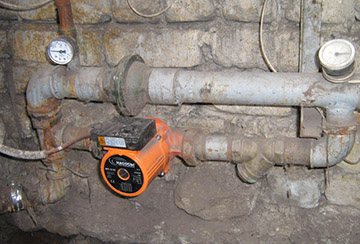

In some homes, the circulation pump simply increases the productivity of the system. That is, it could work without it, but with the pomp, the efficiency increases. It is a different matter for systems whose work stops if the pump does not work.
For example, underfloor heating systems. The length of the tubes in them is such that the resistance does not allow water to circulate naturally.
The same can be said about large premises, cottages on several floors. A special category is boilers with a closed combustion chamber. Their work is carried out only with forced removal of gases.
In all these cases, having a UPS in the heating system is not a whim, but a necessity.
The time that the UPS can maintain heating without electricity depends on the number and capacity of the batteries purchased.
The UPS supplies energy from the batteries, and equalizes the mains voltage (not all models - see below), protects against overheating and short circuits.


